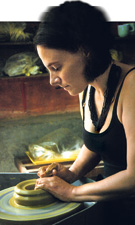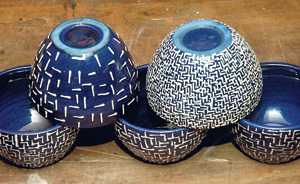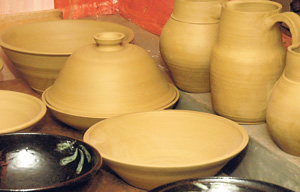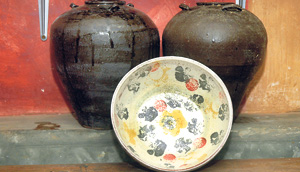Donning an apron, Sabine Wittachy sits at one of her electric potter’s wheels. Slapping on a lump of clay, she deftly makes a central cavity, raising and smoothening the sides of the sample piece, which is ready in a matter of minutes.
Picture this scene in a Nugegoda studio, a long way away from Sabine’s native Switzerland.
Life is known to take strange twists and turns; so too for Sabine who started her professional career as a pharmacist’s assistant. “I’ve always wanted to use my hands and love the contact with clay,” says Sabine who followed the occasional ceramics class.
Finally giving into an inner calling, she enrolled at the School of Applied Art in Vevey, Switzerland in 1996, spending four years specialising in ceramics.
Another twist came a year before art school ended. Sabine met a Sri Lankan who was looking for ceramists to come and help rejuvenate the local industry. So more than 10 years ago Sabine came for the first time to a small ceramics factory at Tissamaharama to conduct a short-needs assessment.
Returning to Vevey, she completed her arts baccalaureate, simultaneously raising funds to enable her to return to Tissamaharama to carry out a six-month project.
Bagging the most distinguished student of the year award helped boost her project purse and spirit. Perhaps she was destined to make Sri Lanka her home for she met her future husband quite early on during her second visit. When the project ended, she returned to Switzerland to wrap up, moving once and for all to Sri Lanka. Initially, she did some voluntary arts and ceramics training projects, setting up a small studio in the Lasallian Community Centre in the Colombo suburb of Modera to provide slum children an outlet to express their creativity and enhance their skills.
Five years ago, Sabine established her own cosy studio, tucked away down a leafy Nugegoda street. She was delighted with the space and brought down many tools and materials from Switzerland, including two impressive-looking electrica pottery wheels.
The more difficult aspects lay in sourcing the clay, glaze and kiln materials in situ. She buys the clay from a ceramist in Biyagama and has crafted her own gas-fired kiln, which has seen substantial pottery thoroughfare over the years. She is relieved to have found a local kiln maker though, as she is looking to replace her home-made one at some point, but her search for a local glaze manufacturer has thus far been unsuccessful.
Relatively clean clay dug up from the earth is first dried, put through a sieve and then pushed through a filter press, where it comes out in slabs. The slabs go into an extruder, which mixes the clay thoroughly, releasing it in tubular form, which can be used directly on the wheel. Sabine recently discovered that there’s a sandier, un-purified clay which is ideal for bigger pieces.
Once off the wheel, a piece takes a day to harden, following which its base can be finalised, sometimes a tricky process. When it’s dry again, the first, unglazed or bisquet firing takes place at 950oC; being iron-based clay, the piece turns a reddish hue. Now the ceramist is faced with two choices – to apply coloured glaze, or to first add a coloured liquid clay called slit, and then glaze over. Back the piece goes into the kiln for the second firing at 1000oC. Sabine advises that kiln temperature should rise slowly, about 100oC per hour, as there’s always the danger that clay particles might crack.
The final stage involves leaving the kiln to cool for a couple of days, before the finished piece can be removed safely. Non-iron clay can withstand even higher temperatures of 1250oC, its advantage being that it is non-porous, so there’s no need to apply glaze; however, it’s advisable to do so. Sabine’s hope is that her new kiln will be able to support high glaze firing.
For the last six years, Sabine has been the Secretary and Project Co-ordinator on the board of the Individual Development Education School for disabled children, currently located on Nawala Road, but in search of new premises. To raise funds for the school, she organises twice-yearly garage sales of goods mainly donated by departing expatriates; these have been very successful, raising Rs. 65,000 the last time. The next sale is due to take place towards the end of the month.
“I like big, open, calming pieces and simple colours. I’m inspired by sensation rather than colour,” she explains. While she could use a technique to make each piece perfect, she prefers to impart a hand-made finish, which is the inherent charm of her products. As Sabine chooses not to mass produce her pieces, each has a unique, individual character and is signed “SAB”. She takes on custom-made orders and is always sad to part with her pieces, but there’s only so much she can keep for herself.
“I’ve always wanted to share my art, not lock myself away,” reveals Sabine, who has long-advertised her ceramics classes among friends, to enable people to enjoy the art form. She’s had a regular stream of students over the years and says two per class is optimum for specialised attention. It’s Sabine’s belief that there’s something for everyone in ceramics and she’s looking for an opportunity to share her craft with new students. |





